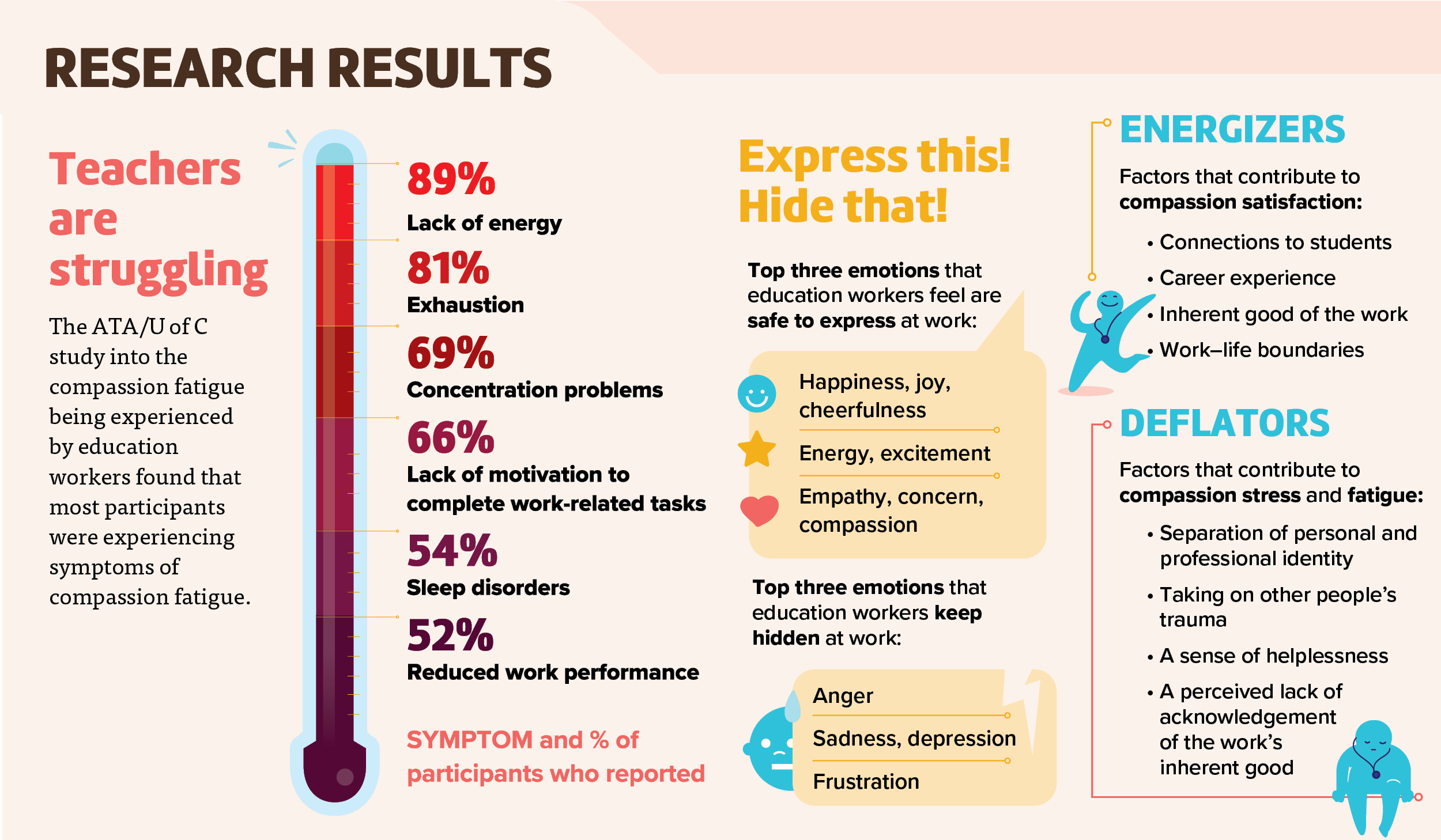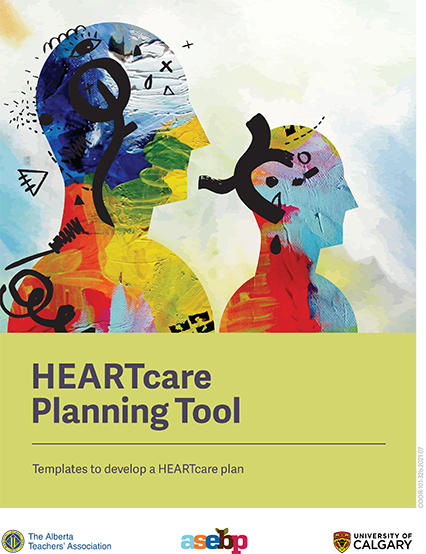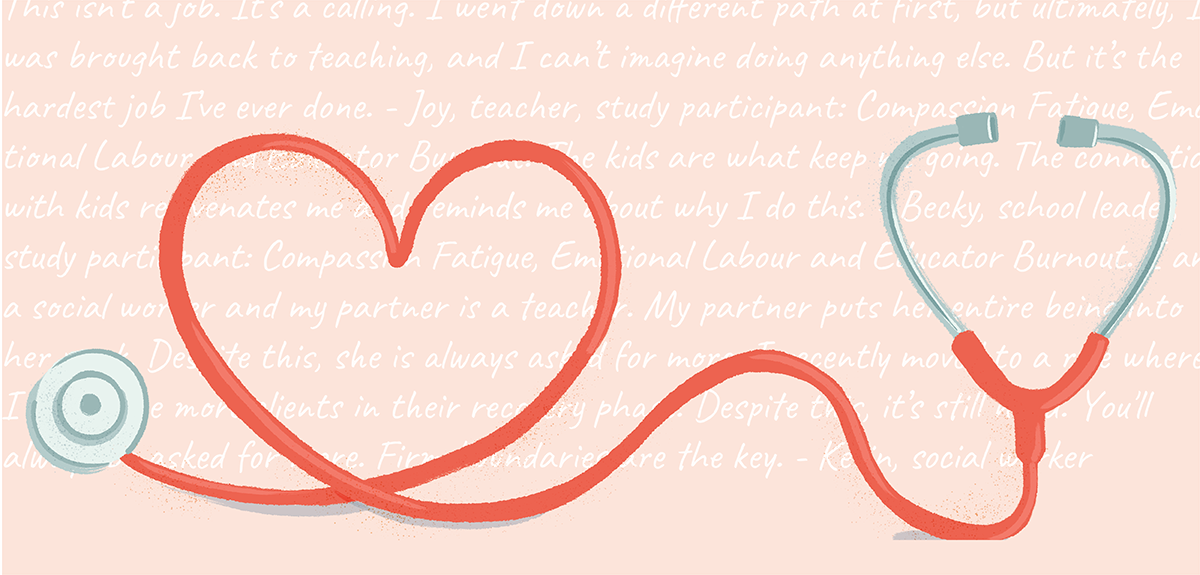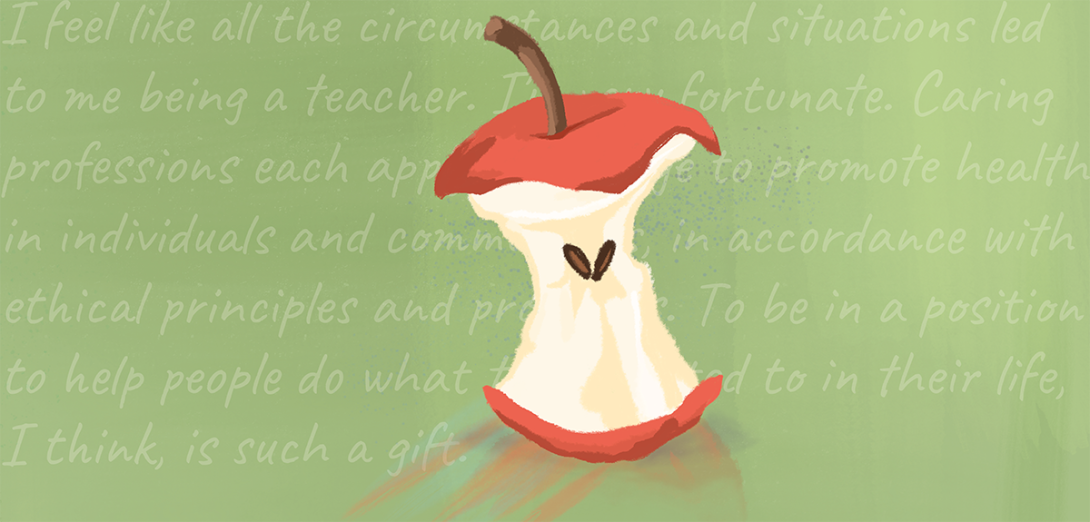From 2020 to 2021, the Alberta Teachers’ Association partnered with University of Calgary researcher Astrid Kendrick to study the lived experiences of educational workers regarding three phenomena that are inextricably tied to working with people: emotional labour, compassion satisfaction/stress/fatigue and burnout. The study was designed to address a research gap and find meaningful supports for teachers, school leaders, central office leaders and other educational workers.
The following information has been compiled from the study’s research reports, which are available at heartcareeducators.ca.
The Theory
Emotional labour and the rules of engagement
Coined by American researcher Arlie Hochschild, the term “emotional labour” is the performance of expected emotional expression in a work environment. In other words, employees are expected to manage their emotions in a manner that matches the organizational “feeling rules”—the spoken or unspoken expectations of how a “good” employee expresses or represses their emotions when working.
Feeling rules apply whether or not the employee genuinely feels the respective emotions, leading to a potential disconnect between the organizational feeling rules and the employee’s authentic emotional state.
Hochschild advances the idea that emotional labour involves deep acting and surface acting.
With deep acting, the employee’s true emotional state aligns with the organizational feeling rules and provides a strong base for the employee to perform the emotional labour. The employee feels a strong connection to their work and can identify with their job role as a part of themselves. In the educational field, this person might feel a strong desire to positively influence children and youth or create an optimal school–work environment for staff and colleagues. Their individual passions and drive align with the expectations for their profession.
Surface acting is necessary when a worker’s actual emotional state does not align with the organizational feeling rules. Ongoing surface acting has been linked to burnout and compassion fatigue, as it can erode the passion that drives educators to contribute their skills and abilities to create a better and more civil society.
Compassion satisfaction, stress and fatigue: The price of being empathetic
Compassion satisfaction is the pleasure that caregivers experience from doing their work. Compassion stress and compassion fatigue, on the other hand, exist on opposite ends of a continuum representing the emotional toll that caregivers may experience in the course of doing their work.
Compassion stress—People can still manage their daily workload and can rely on individual or workplace strategies to recover.
Compassion fatigue—Requires intensive interventions such as professional therapy, medication or a leave of absence from work to fully recover.
For people engaged in helping professions, the toll of performing empathy and compassion when feeling otherwise can be stressful and lead to emotional exhaustion. Research has found that a strong stigma is attached to caregivers admitting to feeling burned out, which can exacerbate the effects of compassion stress and compassion fatigue.
Burnout: Helping others has long-term impact
Burnout is a career-long process that occurs in caregivers as they help other people. If left unchecked, burnout typically grows in intensity over time. In humanservice work, individuals who are highly motivated, dedicated and emotionally involved in their work are most vulnerable to burnout, research suggests.
According to the Maslach and Jackson Burnout Scale, there are three main aspects of burnout:
Depersonalization
- treating clients as if they were impersonal objects
- becoming more callous toward clients
Emotional exhaustion
- feeling tired at the beginning and end of the
- work day
- feeling frustrated by the job
Lack of accomplishment
- lacking energy
- unable to deal effectively with client needs or positively influence their lives

Occupational heartbreak
Occupational heartbreak occurs when a strongly passionate person experiences a loss as the result of a change at work, says researcher Astrid Kendrick.
Education workers and other caregiving professionals tend to enter their professions with honest intentions and a desire to make a difference in
students’ lives. When presented with crisis or trauma work, or when their efforts do not bring about the acknowledgement or success they had hoped for, these workers feel a deep loss, Kendrick has found.
Conversely, when their heartwork is rewarded with student success, workers report that they are able to persevere through crisis or trauma work.

Intervention
Compassion stress, compassion fatigue and burnout are preventable and treatable. Both individuals and organizations can effectively prevent or treat these phenomena through professional development, self-care plans, effective mentorship and supervision, and the work culture.
Professional development
Preparing educational workers for the likelihood of experiencing compassion fatigue, compassion stress or burnout requires training them to recognize the risk factors for both themselves and their colleagues.
Self-care planning
Caregivers should develop a strong self-care plan that includes a wide number of coping strategies and resources that an individual can access in times of stress. Leaders in organizations that rely on employees providing emotional labour should work to ensure that each employee has a self-care plan that includes individual, organizational and professional interventions.
Mentorship and supervision
Providing caregivers with regular access to and communication with peers and mentors who have worked with traumatized clients is another way that organizational leaders can help prevent or treat compassion stress, compassion fatigue and burnout in their employees.
Workplace culture
Developing a healthy workplace culture includes ensuring that employees have access to supports and resources so that they can enact their self-care plan; providing training and professional development regarding compassion fatigue, compassion stress and burnout; and acknowledging that these phenomena are not individual failings or the results of a personal problem; they are the cost of caring and a consequence of working with traumatized people.
Tools available
Several reliable and validated tools exist that can help an individual to self-identify their compassion fatigue. The ProQOLSurvey Version 5 is considered the strongest measure to assess an individual’s proclivity toward compassion satisfaction and compassion fatigue. It is available at proqol.org/proqol-measure.
The ATA/U of C study produced a HEARTcare Planning Tool to help teachers address the emotional challenges of their work. It’s available at heartcareeducators.ca.

Insights from caring professionals
My greatest goal is to make the broadest and deepest positive impact in the most kids’ lives that I can while I’m here, and as long as I do that, I feel like I’ve been successful.
– Oswald, teacher, study participant: Compassion Fatigue, Emotional Labour and Educator Burnout
When I first started [teaching] ... I was trying to save the world, and make sure that every kid was getting the best of me all the time. That’s not feasible. I’ve definitely shifted now to [seeing that] I’m part of a web — I’m one person in the student’s life, and I can help them when I’m there, but I am my own person, and I need to be healthy, and I need to be here for my children and my mom.
– Betty, teacher, study participant: Compassion Fatigue, Emotional Labour and Educator Burnout
The kids are what keep me going. The connection with kids rejuvenates me and reminds me about why I do this.
– Becky, school leader, study participant: Compassion Fatigue, Emotional Labour and Educator Burnout
I think being a teacher is an extremely important job. I enjoy my work, and I love working with kids. I care deeply about them, but I’ve learned that there has to be balance in my life. I don’t get hung up on the things I can’t change about my job. I do my best, but I also save some of my energy for my family and my personal life.
– Teacher, study participant: Compassion Fatigue, Emotional Labour and Educator Burnout
I often feel overwhelmed by the various emotional, behavioural and academic needs of my students, and I feel pressure to address them all, even with limited support. When I can’t effectively address my students’ needs, I feel guilt and shame that I’ve failed, and I feel angry at the system for expecting teachers to manage so much and do so much with so little support.
– Teacher, study participant: Compassion Fatigue, Emotional Labour and Educator Burnout
Caring professions are some of the most rewarding career paths. As a teacher for 15 years and now as a paramedic for 10, I have had the opportunity to impact the lives of students and patients in innumerable ways. Being of service to others is a privilege. However, it can come at a price. It wasn’t until leaving education that I realized how I had let it consume my life. I carried that learning into EMS and now focus on prioritizing myself so I am better able to care for others.
– Helene Hamilton, primary care paramedic and former teacher
Many people are motivated in these fields by a personal experience. I have observed that this very personal aspect can also be a major pitfall. The work can be triggering in ways you don’t expect and aren’t equipped for. It’s also easy to fall into the trap of taking responsibility for things you can’t change and decisions that belong to others. I think it’s incredibly important to know yourself, what you can handle and when you need to set boundaries. If you’re not OK, your ability to support the people you serve is compromised.
I am a social worker and my partner is a teacher. My partner puts her
entire being into her work. Despite this, she is always asked for more. I
recently moved to a role where I get to see more clients in their recovery
phase. Despite this, it’s still hard. You'll always be asked for more. Firm
boundaries are the key.
– Kevin, social worker



